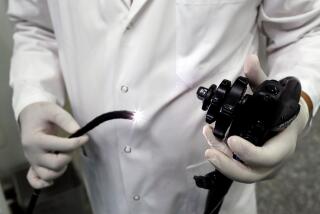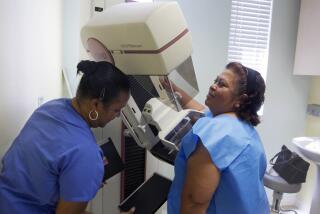Why Do We Play Russian Roulette With Our Lives?
- Share via
Despite repeated exhortations from health experts--and even from celebrities like Gen. H. Norman Schwarzkopf--Americans just don’t get it when it comes to cancer screening guidelines.
That’s why last week’s decision by the National Cancer Institute to leave mammography recommendations for women ages 40 to 49 up to individual doctors and their patients was dismaying to many health experts.
Even though there is little disagreement about most cancer screening tests, and the benefits of those tests are overwhelmingly clear, the mammography controversy may lead Americans to perceive screening as too controversial, ever changing or complicated to deal with.
Preventive health experts would far rather that Americans view cancer screening as easy, cost-effective and lifesaving. But low compliance rates for most of the recommended screening tests show this is not the case.
“I think a lot of the impact of screening is lost on Americans,” says Dr. Stephen McPhee, a professor of medicine at UC San Francisco who has studied compliance rates. “I don’t think people realize how much these things save lives.”
Despite great effort to find cures, cancer continues to dwarf almost all other health threats. This year, an estimated 1,382,400 new cancer cases will occur, accompanied by 560,000 deaths.
And yet about half of all new cancers are types that can be detected early, when the chances for a cure are sizable, according to the American Cancer Society. These include cancers of the breast, tongue, mouth, colon, rectum, cervix, prostate, testes and skin.
Indeed, the U.S. cancer death rate fell by nearly 3% between 1991 and 1995, the first sustained decline since national record-keeping began in the 1930s. The decline is most likely due to treatment advances, early detection and tobacco control, according to a recent report from the NCI.
And declines in death rates for breast and cervical cancer in women and colorectal cancer in both men and women strongly suggest the role of screening, the report noted.
In contrast, the death rates continue to remain high for bone, brain, soft tissue, lung, pancreatic and liver cancers--diseases for which there are no tools for widespread screening and early detection.
Given the benefits of early detection, health experts struggle to understand the relatively low utilization rates of cancer screening tests.
“Word has gotten out about screening for breast cancer, and more and more women are going for that. But for other types of cancer, screening rates are very low,” says Roshan Bastani, associate director of the Cancer Control Division at Jonsson Comprehensive Cancer Center at UCLA, who has studied compliance rates. “Colorectal screening levels, for example, are dismal. We need to study why people don’t do that.”
Clearly, experts note, the fact that early detection can increase the chances for a cure is not enough to motivate Americans to meet the American Cancer Society’s list of recommendations for early screening (See box).
Studies on compliance rates show there are numerous reasons people don’t adhere to the guidelines, including the costs entailed, convenience, confidence in the test’s accuracy, having the support of one’s doctor and fearing the outcome.
The role of the primary care doctor, in particular, is thought to be a key to improved screening rates, says Dr. Lawrence W. Bassett, director of the Iris Cantor Center for Breast Imaging at UCLA. Bassett helped direct a study a few years ago on what prompts women to get mammograms.
“One of most common reasons women gave for not having mammograms done was because their doctor didn’t recommend it. If the woman’s family physician is supportive they would be more likely to go,” he says.
The study also found that younger doctors tended to be more prevention-oriented than older doctors, Bassett says.
Even the most well-intentioned doctors, however, can forget to suggest routine cancer screens, says McPhee, who has led an effort to use a computerized system to remind both doctors and patients of when cancer screens and other preventive treatments or tests are due.
“Doctors often use checklists or refer to manuals or use stickers or flags on patients’ charts,” McPhee says. “But the computer reminders are more accessible and more sophisticated.”
*
McPhee’s survey of 52 doctors showed that the main reasons for not doing recommended screening tests was their own forgetfulness, accounting for 25% to 50% of the missed screening opportunities.
“In the managed care era, doctors have to be forced to look at exactly what needs to be done,” McPhee says. “You get preventive care done by being very efficient. A doctor needs to say, ‘Yes, [the patient] is here for her hemorrhoids, but she also needs her mammogram.’ ”
Even when the doctor recommends a test, however, it is up to the patient to follow through. McPhee’s study showed patients refused screening in many instances, including half of all the cases in which rectal or pelvic exams were recommended. Patients refused mammograms in 23% of the cases.
The high cost of some tests can also be a deterrent, says Dr. Robert Figlin, director of the clinical research unit at Jonsson Comprehensive Cancer Center.
Insurance plans typically cover mammography (sometimes only in women older than 50), Pap tests and colorectal screening. But coverage of even these tests can vary by plan and even within a plan depending on which geographical area a consumer resides in, experts note.
But even if their doctor recommends it and their insurance will pay, thousands of consumers pass up the chance to discover cancer in its earliest stage.
A look at the most accepted (and reimbursed) of the cancer screening tests shows low compliance rates, although there have been improvements in recent years.
* A National Health Interview Survey found that the number of women 40 and older who reported having had a mammogram increased from 36.3% in 1987 to 68% in 1992. Yet only 30% of women 50 and older reported having had one within the past year.
* After three decades of promotion, the Pap test is largely the reason why cervical cancer deaths have dropped sharply. But, overall, Pap screening rates have not changed substantially in recent years. From 1987 to 1992, about 67% of American women reported having had a test recently, compared to about 64% in 1973.
* In 1993, 40% adults said they had had a digital rectal exam within the past year and 37% reported having had at least one proctoscopic exam.
* A survey showed the proportion of women 50 and older who had ever had a fecal occult blood test increased from 20% in 1980 to 47% in 1987. In men 50 and older, compliance rates increased from 17% in 1980 to 43% in 1987.
*
Studies show consumers harbor great anxieties about cancer screening, although they often comply with the recommendations after having survived their first test and learning it was negative.
“Patients are most comfortable the day after they learn the screening is normal and the most uncomfortable right before undergoing screening for the first time,” Figlin says. “That’s the dynamic of screening.”
Adds Bassett: “I think all of us don’t want to take a test where the outcome may be bad. Most of the time, however, there will be a good outcome. And that is a good reassurance to have.”
Experts acknowledge that there may be many other reasons people don’t adhere to screenings and that those reasons may relate to their ethnicity, education level and age.
Bastani, for example, is studying minority women and their adherence to screening recommendations.
“We hear different reasons why people won’t comply,” she says. “Among Hispanics, you hear about fatalism: ‘What will be, will be.’ ”
Health experts say they also need to improve compliance rates in the elderly. While younger generations appear to be more accepting of preventive tests, the elderly--who are at highest risk for cancer--often have the worst rates.
“We don’t have enough information for the elderly patients and they are not being targeted for some of the [public service] campaigns to improve compliance,” Bassett says. “Also, it’s new for them. We need to learn more about what we can do for the elderly patient. Cancers are actually easier to pick up in that age group. They are likely to be more curable.”
The idea of continuing screening into very old age is also a new one, Bastani says.
“Twenty or 30 years ago people felt, ‘Why should we screen older people?’ But now someone 65 may live 30 or 40 more years, and we want them to be healthy.”
Resources
For more information on prevention, early detection or treatment of cancer, call:
* National Cancer Institute (800) 4-CANCER (services available in English and Spanish); TTY: (800) 332-8615.
* American Cancer Society (800) ACS-2345; or on the Internet at https://www.cancer.org.
(BEGIN TEXT OF INFOBOX / INFOGRAPHIC)
Cancer Screening for the Asymptomatic Person
Cancer site: Breast
Test: Self-exam
Sex: F
Age: 20+
Frequency: Every month
*
Cancer site: Breast
Test: Clinical exam
Sex: F
Age: 20-39, 40+
Frequency: Every 3 years, Every year
*
Cancer site: Breast
Test: Mammography
Sex: F
Age: 40-49, 50+
Frequency: Every 1-2 years, Every year
*
Cancer site: Cervix Uteri
Test: Pap test
Sex: F
Age: 18-39 or who are sexually active
Frequency: Every year or less frequently after 3 or more consecutive normal annual tests
*
Cancer site: Cervix Uteri
Test: Pelvic exam
Sex: F
Age: 18-39, 40+
Frequency: Every 1-3 years, Every year
*
Cancer site: Colorectal
Test: Digital rectal exam
Sex: M & F
Age: 40+
Frequency: Every year
*
Cancer site: Colorectal
Test: Fecal occult blood test
Sex: M & F
Age: 50+
Frequency: Every year
*
Cancer site: Colorectal
Test: Sigmoidoscopy
Sex: M & F
Age: 50+
Frequency: Every 3-5 years
*
Cancer site: Corpus Uteri
Test: Endometrial biopsy
Sex: F
Age: At menopause if at high risk
Frequency:
*
Cancer site: Prostate
Test: Digital rectal exam
Sex: M
Age: 40+
Frequency: Every year
*
Cancer site: Prostate
Test: Prostate specific antigen
Sex: M
Age: 50+
Frequency: Every year
*
Cancer site: Other
Test: Counseling & cancer checkup
Sex: M & F
Age: 20-39, 40+
Frequency: Every 3 years, Every year
Other screening opportunities:
Dentists should look for cancers of the oral cavity at each exam.
Testicular self-exam is recommended in young men.
Women at high risk for ovarian cancer can undergo a blood test called the CA-125 tumor marker test and/or a trans-vaginal ultrasound.
People at high risk for lung cancer can have chest X-rays, tests to examine cells in sputum or a fiber-optic exam of the bronchial passages.
Skin examinations should be done at regular annual checkups; adults should practice skin self-exam on a monthly basis.
Source: American Cancer Society






